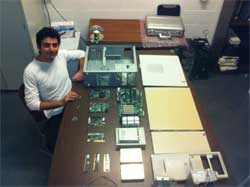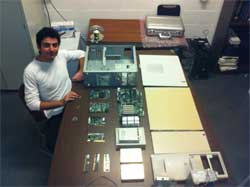 KINGSTON, R.I. – October 23, 2012 – Representatives of some of the best-known consumer products are following the lead of a University of Rhode Island engineer to make their manufacturing processes more environmentally friendly.
KINGSTON, R.I. – October 23, 2012 – Representatives of some of the best-known consumer products are following the lead of a University of Rhode Island engineer to make their manufacturing processes more environmentally friendly.
At a meeting this month at URI, representatives of L.L. Bean, A.T. Cross and the Rhode Island Resource Recovery Corp. joined sustainability advocates and researchers from eight countries to discuss the hurdles to making products more sustainable.
“It’s in part the consumer economy – disposable products and those with a short useful life — that has caused problems with sustainability,” said Manbir Sodhi, URI professor of industrial engineering. “So those are the products we want to focus on making more sustainable. How can the consumer keep a product longer? How can the manufacturer take their product back to recycle it?”
Sodhi points to the manufacturing philosophy of the 1960s and 70s that he called “design for obsolescence,” which spurred companies to intentionally design products that would need to be replaced quickly. While it may have boosted the economy, it was a wasteful strategy.
“Now we want to design products so they retain value longer,” Sodhi said. “It’s going to be all about reverse supply-chain logistics that ultimately brings the product back to the manufacturer. It forces companies to think about how to take it back and what to do with it. They might have to spend a little more money at the beginning, but they’ll save money in the end.”
One way that Sodhi looked at the problem was by taking apart several products – a car, a microwave, a computer, others – and finding out how much each individual part would cost if the product needed to be repaired. He found that the combined cost of the parts was 10-12 times more expensive than the cost of the whole product.
“Clearly there is a disincentive to repair products, if it costs so much to buy parts. It’s so much cheaper to just throw the product away and buy a new one,” he said. “Is that disincentive built in by the manufacturers or by the market? And is it the same in countries where labor is cheap?”
Sodhi is undertaking other research projects examining related topics, including modeling how to redesign products for recyclability, how to recover heat content and energy in the manufacturing process, and how to “harvest community effort” for collecting and separating materials for recycling. He said that some companies are looking at lifetime warranties or extended service contracts as strategies for making products sustainable.
The URI researcher’s concern, however, is that many products, especially electronics, are having an increasingly shorter life cycle and the total number of products being produced is increasing, which means people are disposing of a greater number of products.
“We need to find a balance between disposable products and sustainability,” he said. “We can’t keep going the way we are.”
Pictured above
Graduate student Masoud Vaziri with a disassembled computer, part of a study of consumer product sustainability and repair costs.
Photo submitted by Professor Manbir Sodhi

